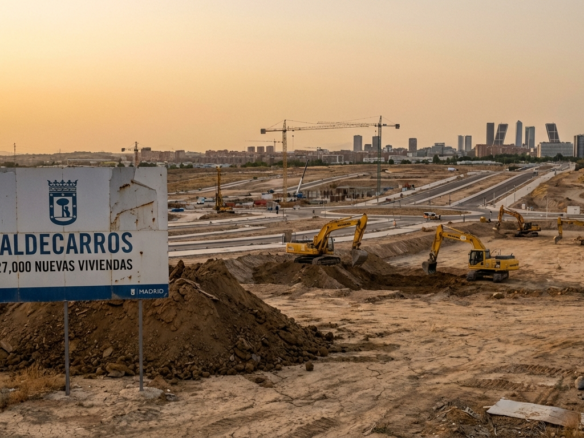Europe’s property finance market is experiencing a significant transformation as it moves away from the turbulent conditions that characterized recent years. After navigating through periods of uncertainty and volatility, the sector is now showing clear signs of stabilization, marking what industry experts consider a pivotal moment for real estate financing across the continent. This shift represents not just a recovery, but a fundamental evolution in how property markets operate within the new economic landscape.
Get 50% OFF!
Subscribe to our newsletter and enjoy a 50% discount on all listing packages, no strings attached!

The transition toward stability is becoming increasingly evident through various market indicators, from lending practices to investment patterns. Financial institutions are adapting their strategies, while investors are regaining confidence in European real estate opportunities. This comprehensive analysis examines the key factors driving this stabilization and what it means for the future of property finance across Europe’s diverse markets.
Property Finance Market Shows Signs of Recovery
The European property finance sector is demonstrating remarkable resilience as market fundamentals strengthen across multiple indicators. Transaction volumes are beginning to normalize after experiencing significant contractions, while lending institutions report improved deal flow and enhanced borrower confidence. Major financial centers including London, Frankfurt, and Paris are witnessing renewed activity in both commercial and residential financing segments, with credit availability expanding gradually but consistently.
Market participants are observing a notable shift in sentiment, with both lenders and borrowers expressing increased optimism about medium-term prospects. The stabilization is particularly evident in core European markets where property values have found solid footing after previous volatility. Banks are reporting improved asset quality in their real estate portfolios, while non-performing loan ratios in property-related lending continue to decline across most EU jurisdictions.
Interest Rates Begin to Stabilize Across EU
European Central Bank policies are creating a more predictable interest rate environment, providing much-needed clarity for property finance decisions. Current lending rates for commercial real estate transactions are settling into ranges that allow for more accurate long-term financial planning, with many lenders offering fixed-rate products extending beyond traditional short-term arrangements. This stability is encouraging both domestic and international investors to re-engage with European property markets.
The convergence of interest rates across different EU member states is facilitating cross-border investment flows and creating more uniform financing conditions. Risk premiums on property lending are compressing as market volatility decreases, resulting in more competitive pricing for quality real estate projects. Financial institutions are increasingly confident in their ability to price risk appropriately, leading to more aggressive competition for prime lending opportunities across major European markets.
Investment Volume Drops 15% But Confidence Returns
Despite experiencing a 15% decline in overall investment volume compared to previous peak levels, European property markets are witnessing a fundamental improvement in investor sentiment and deal quality. The reduction in transaction volume reflects a more selective approach by investors rather than a lack of available capital, with focus shifting toward assets offering stronger long-term value propositions. Institutional investors are particularly active in core markets, demonstrating their confidence in the sector’s stability.
The composition of investment activity is evolving, with increased emphasis on sustainable and technologically advanced properties that align with ESG criteria. Private equity funds and sovereign wealth funds are deploying significant capital reserves into European real estate, indicating strong institutional confidence in the market’s trajectory. While transaction volumes may be lower, the average deal size has increased substantially, suggesting that serious investors are committing larger amounts to carefully selected opportunities.
Banks Ease Lending Standards for Real Estate
European banks are gradually relaxing their lending criteria for real estate projects as risk assessments improve and market conditions stabilize. Loan-to-value ratios are increasing for quality properties, while debt service coverage requirements are becoming more reasonable for borrowers with strong track records. The easing of lending standards is most pronounced for prime commercial properties and residential developments in major metropolitan areas.
Credit committees are processing applications more efficiently, with decision timeframes shortening significantly compared to recent years of heightened caution. Banks are also expanding their appetite for construction and development financing, recognizing the need to support new supply in markets experiencing housing shortages. The improved lending environment is complemented by more flexible covenant structures and longer amortization periods, making financing more accessible for a broader range of property investors and developers.
Regional Markets Adapt to New Economic Reality
Regional property markets across Europe are demonstrating remarkable adaptability as they adjust to evolving economic conditions and investor preferences. Secondary cities are attracting increased attention from investors seeking value opportunities outside traditional core markets, with places like Lyon, Hamburg, and Barcelona experiencing renewed interest. Local markets are benefiting from improved infrastructure connectivity and the continued trend toward decentralization of business activities.
Eastern European markets are showing particularly strong momentum, with countries like Poland, Czech Republic, and Romania attracting significant international capital flows. These markets offer compelling yield premiums while maintaining stable political and economic environments that support long-term investment strategies. The adaptation process includes enhanced transparency, improved legal frameworks, and increased participation from international financial institutions, creating more liquid and efficient regional property markets.
Europe’s property finance market transition toward stability represents a watershed moment for the continent’s real estate sector. The combination of stabilizing interest rates, improved lending conditions, and renewed investor confidence is creating an environment conducive to sustainable growth and long-term value creation. While investment volumes may remain below historical peaks, the quality and sustainability of current market activity suggest a more mature and resilient sector emerging from recent challenges.
Looking ahead, the stabilization trend appears well-established, supported by strong fundamentals and adaptive market participants. The evolution toward more selective investment approaches, combined with banks’ increased lending appetite and regional market development, positions European property finance for continued stability and measured growth. This new phase offers opportunities for patient capital and strategic investors who understand the value of stable, predictable market conditions over volatile boom-bust cycles.





Join The Discussion